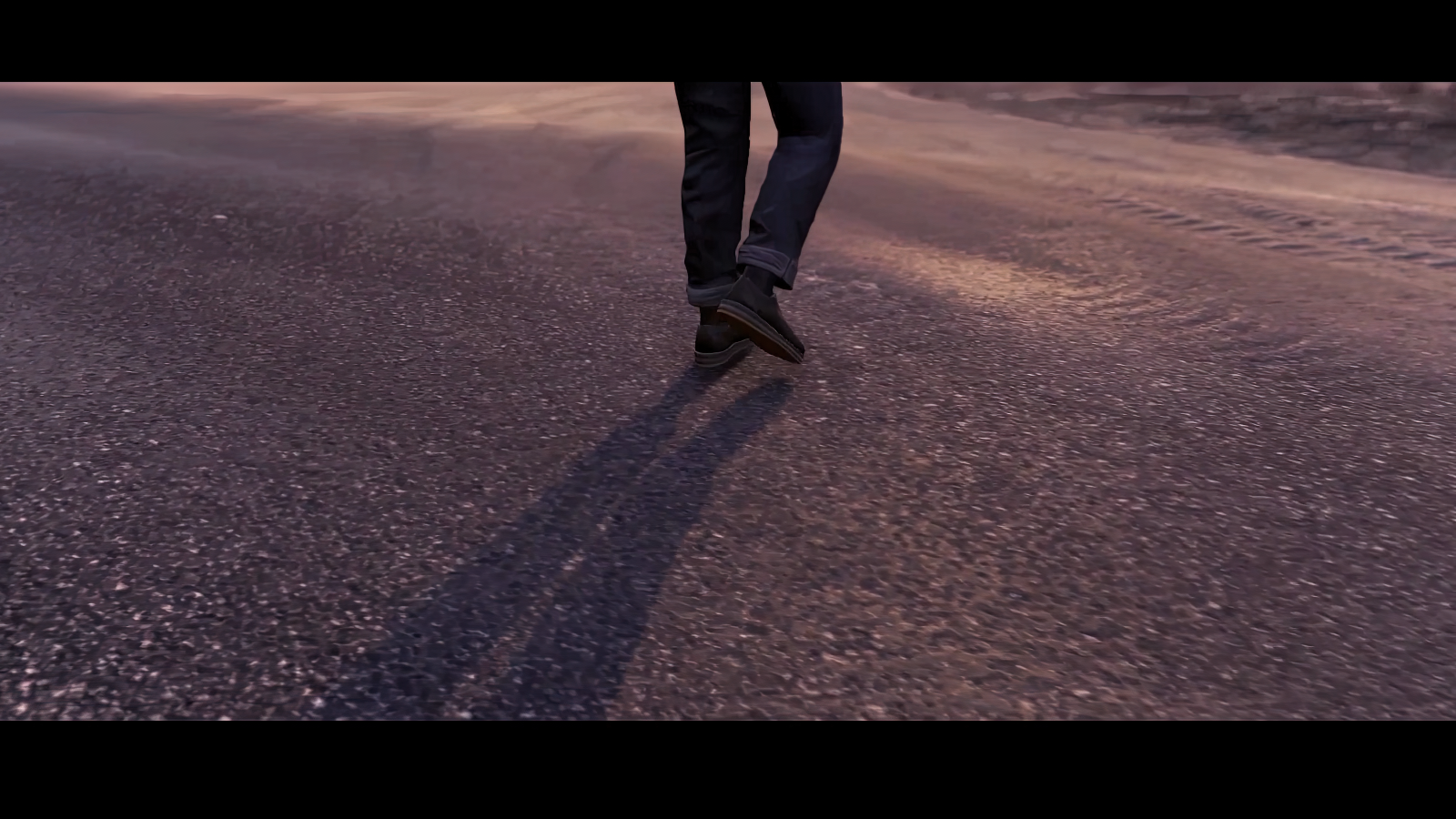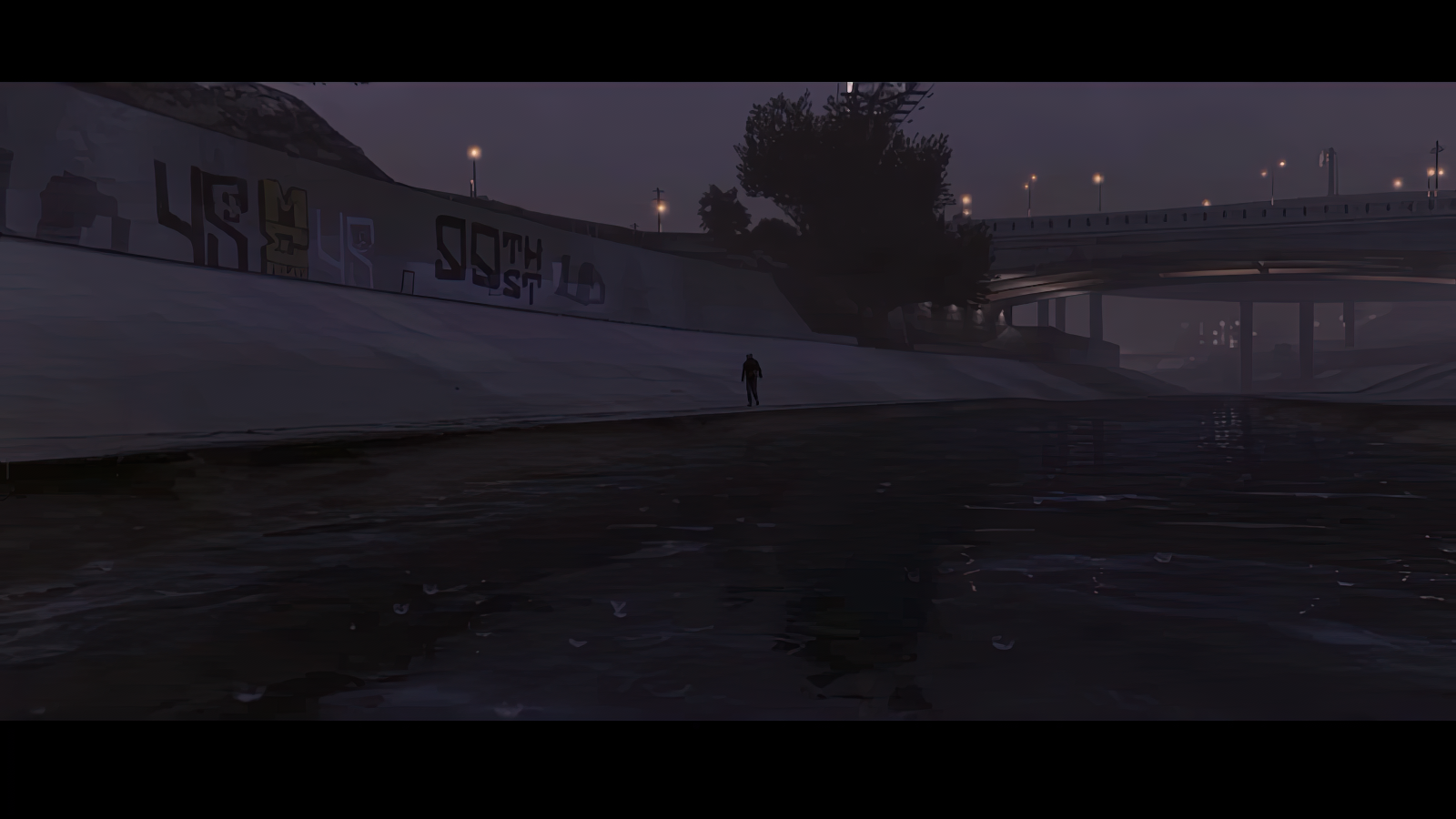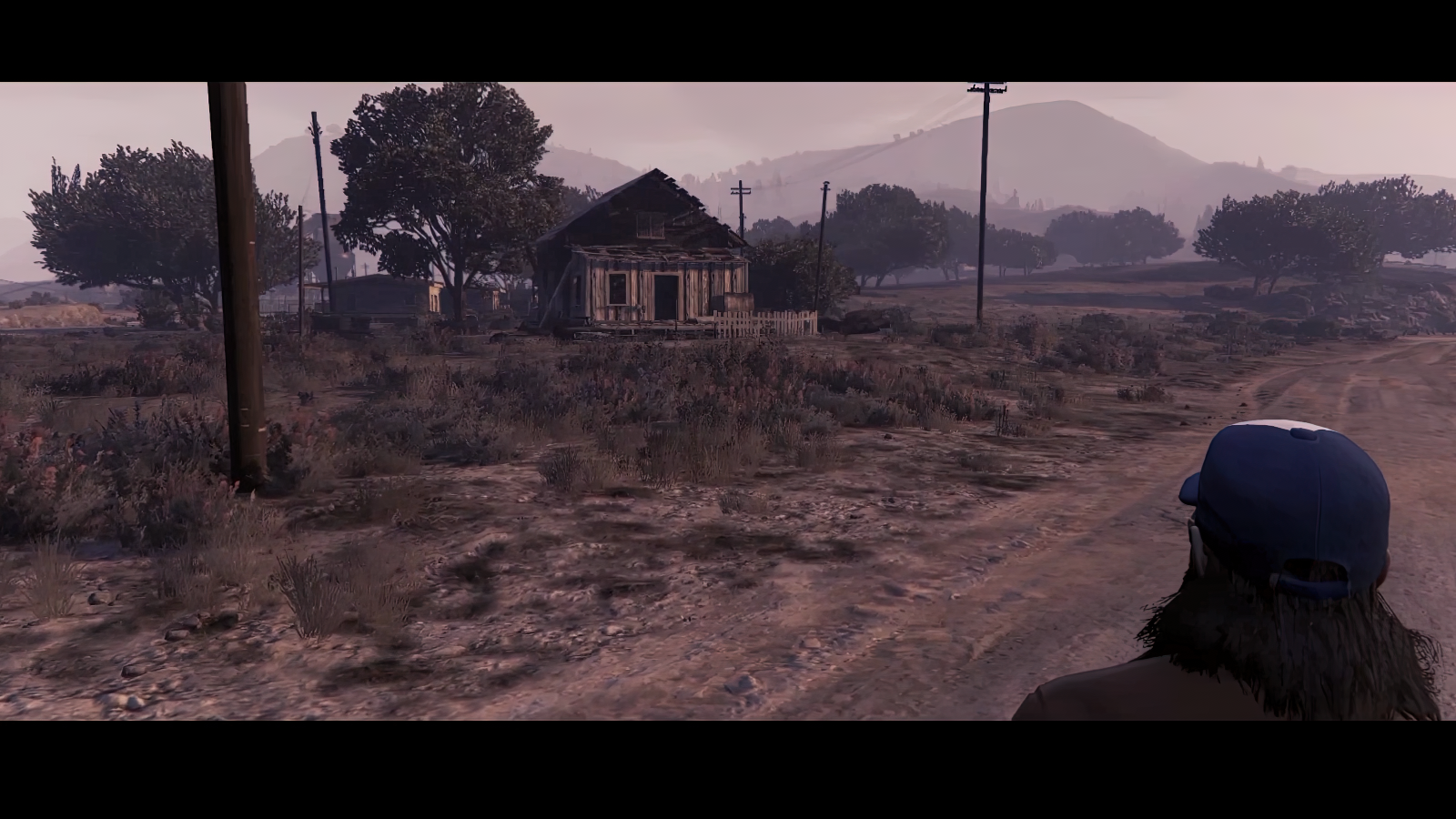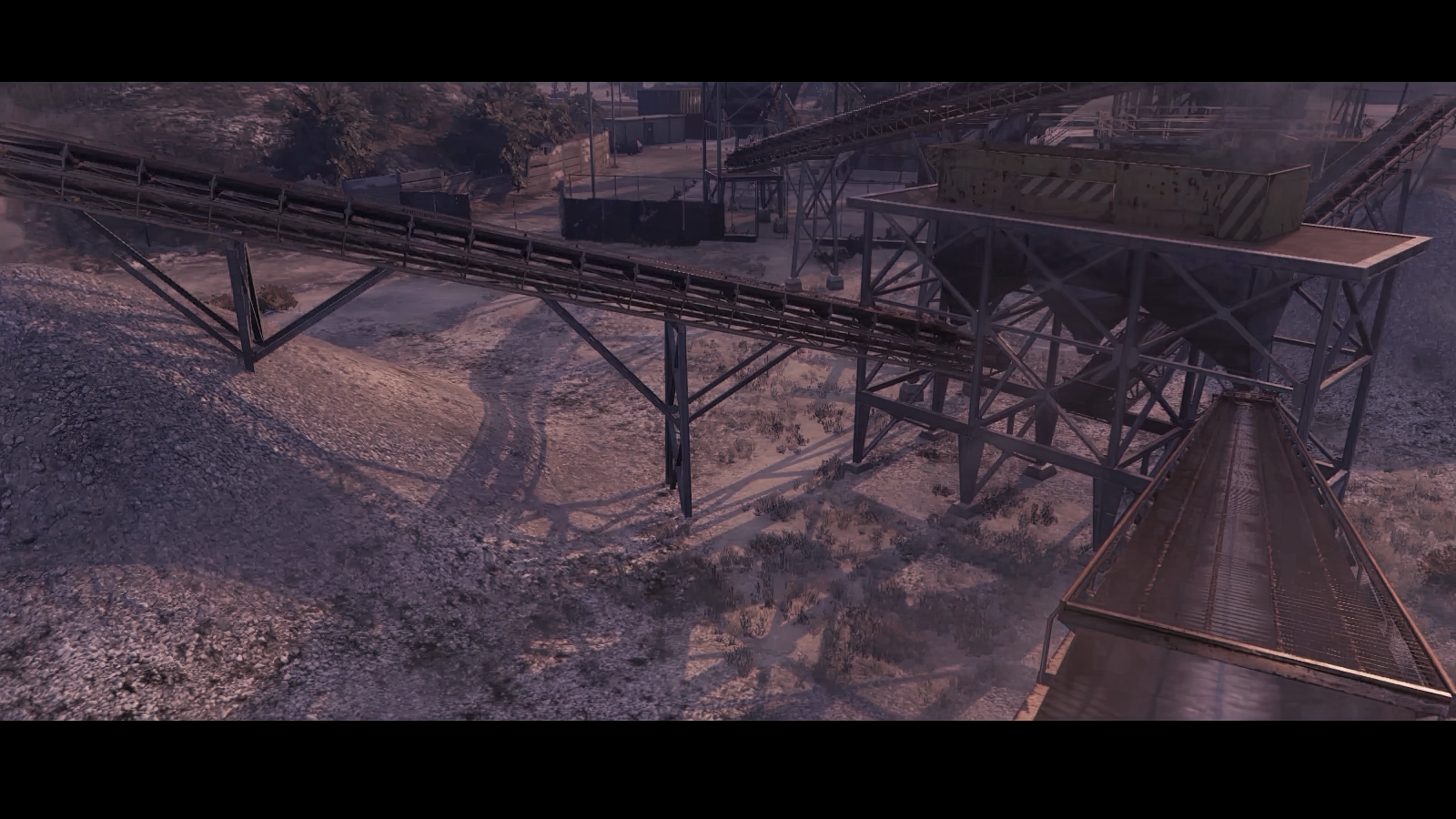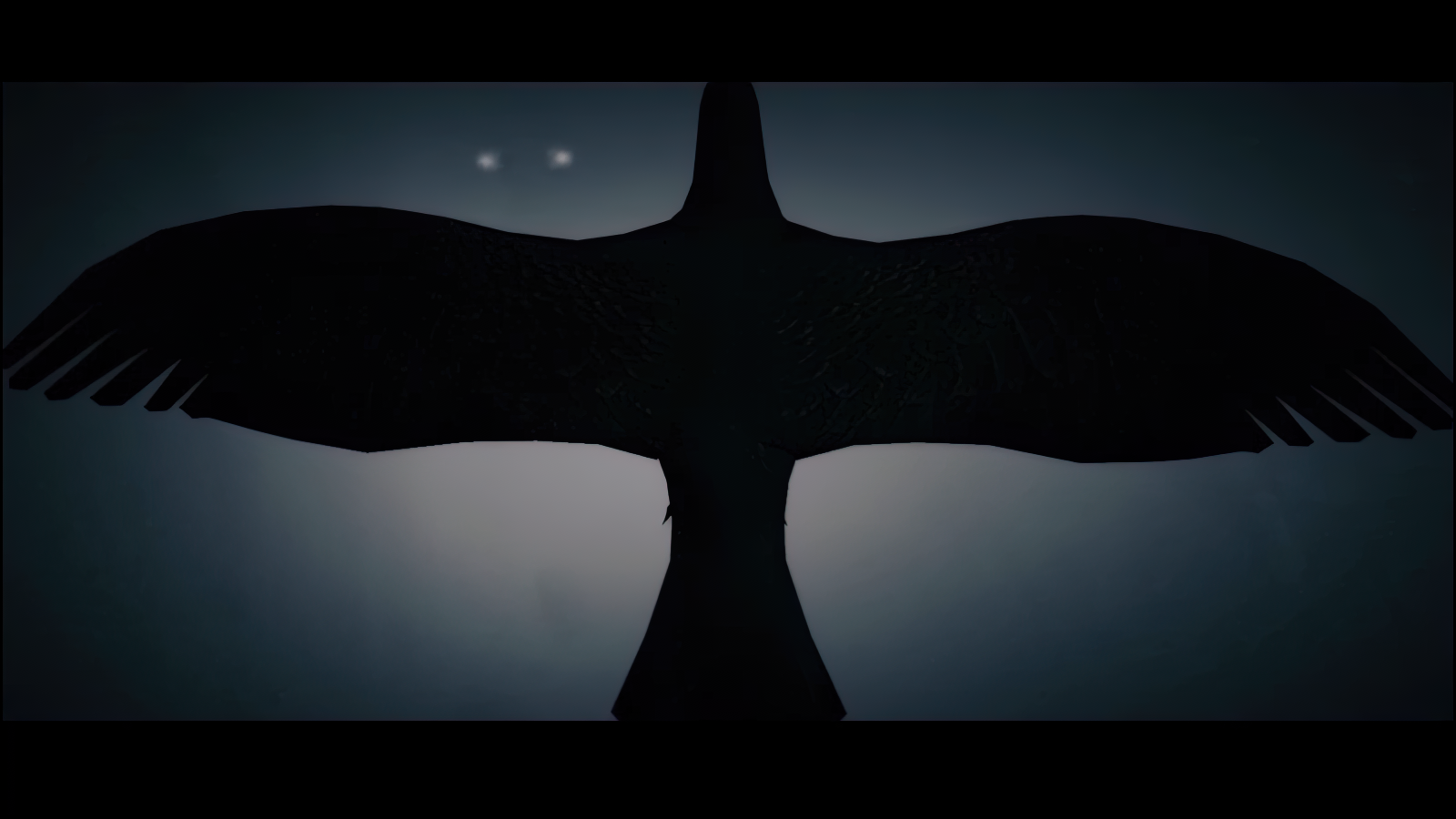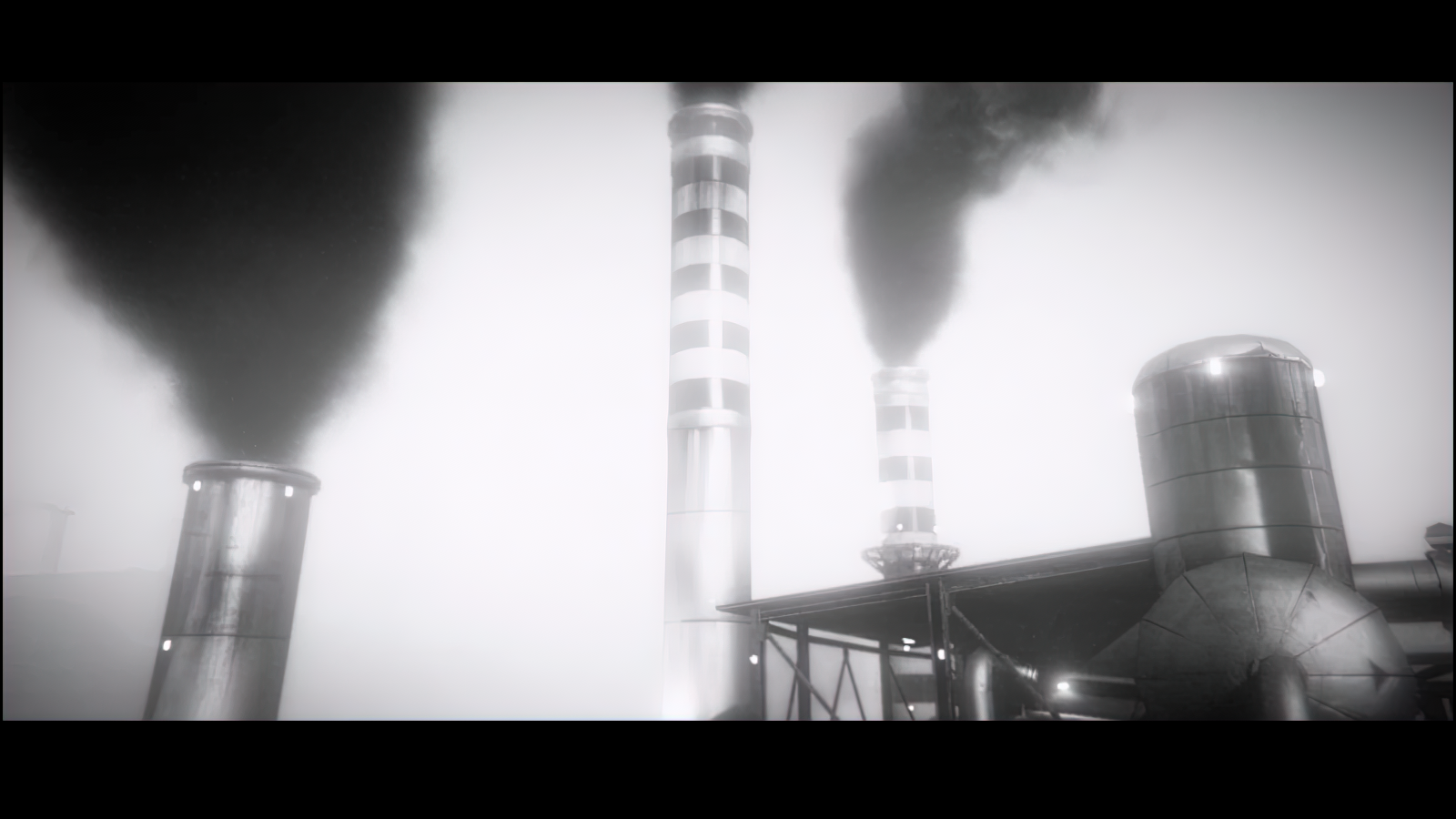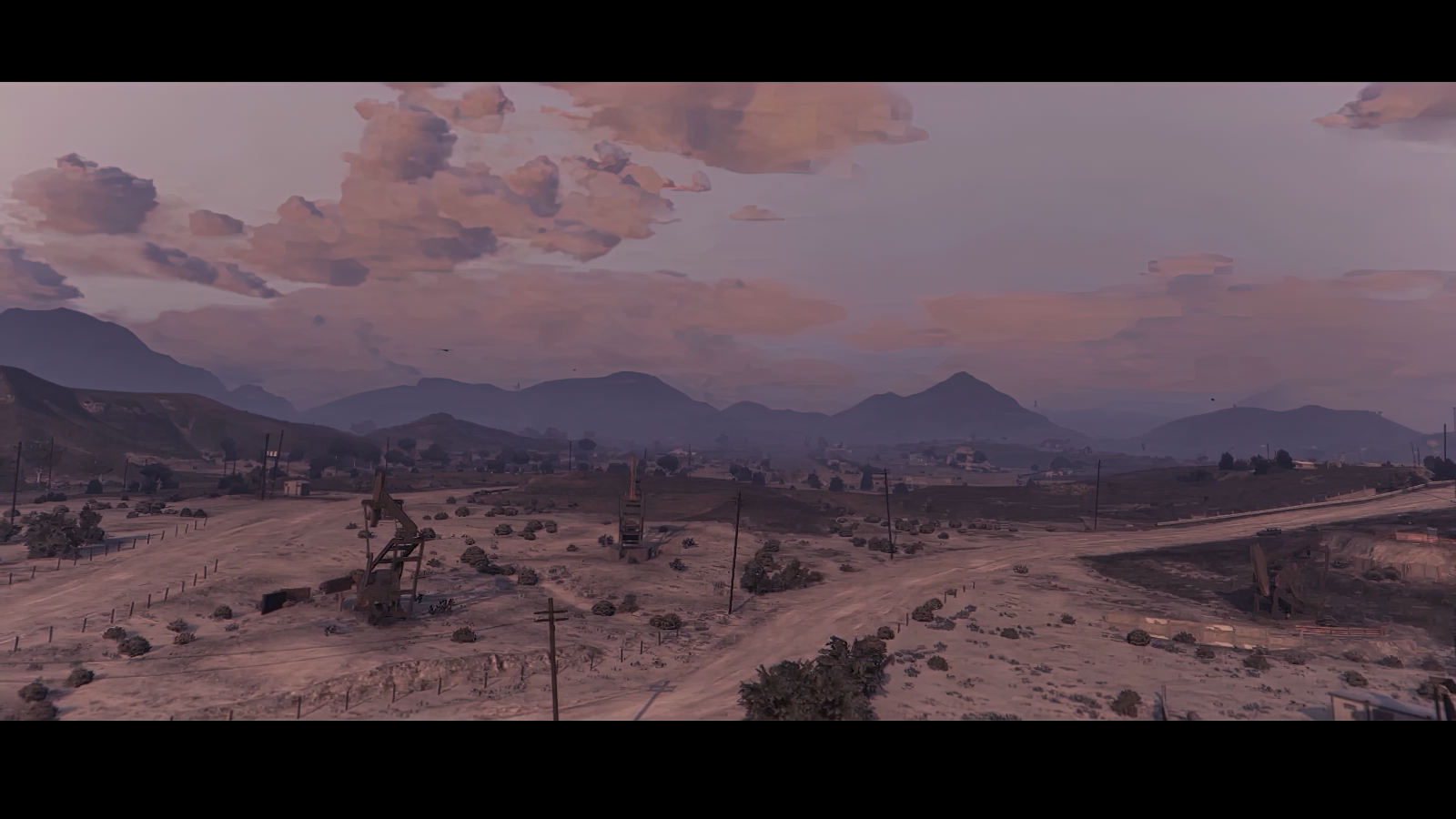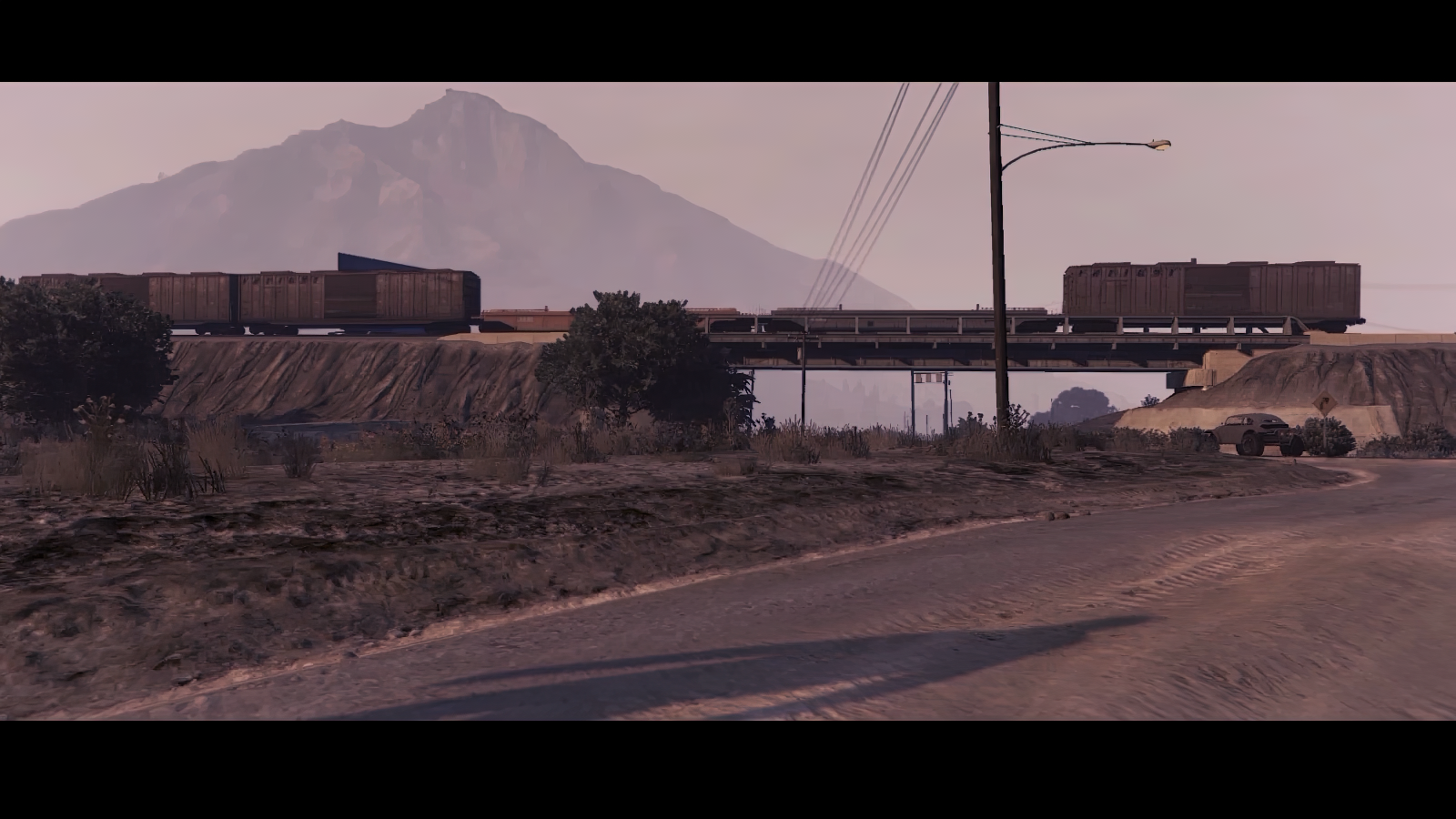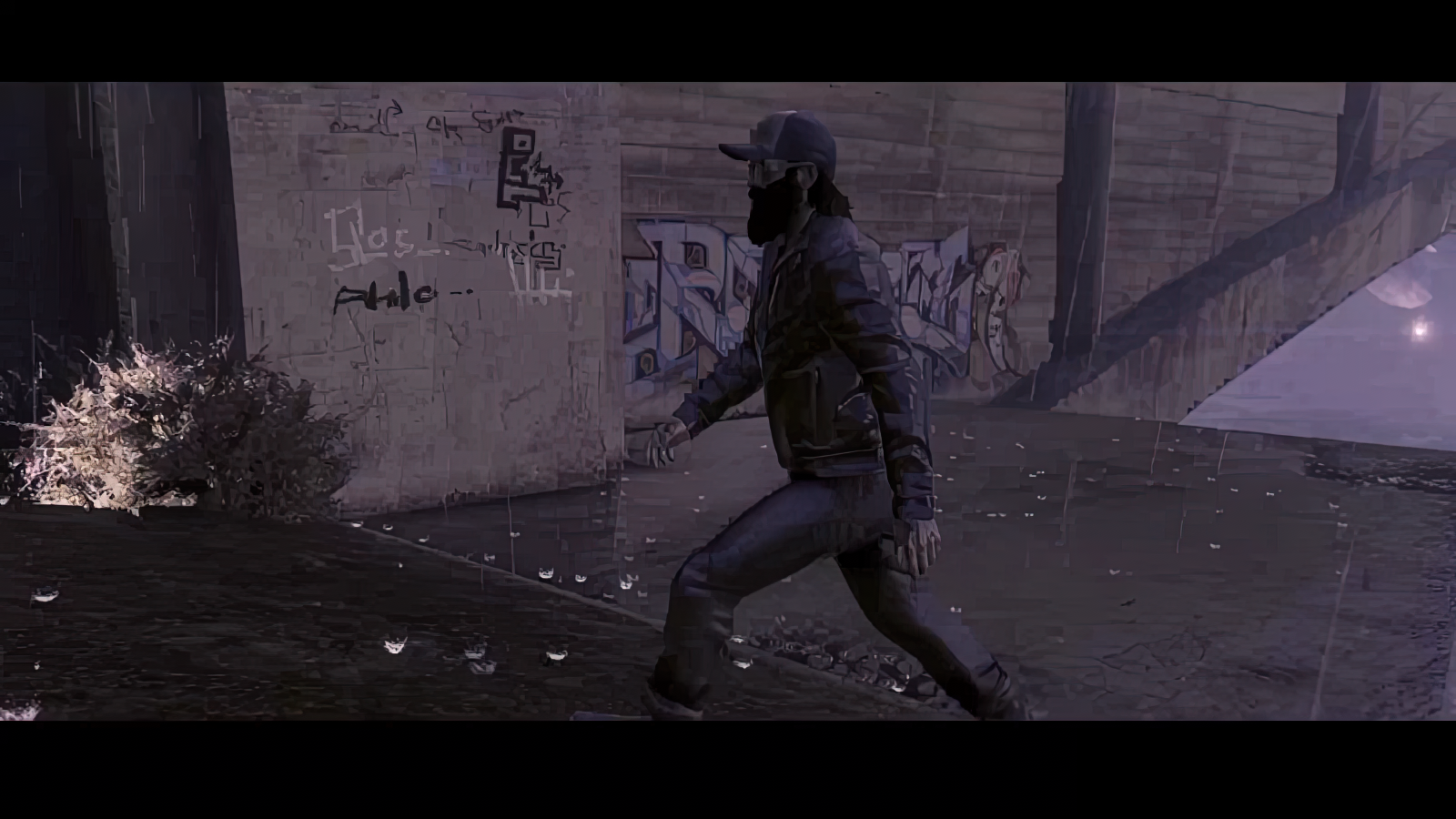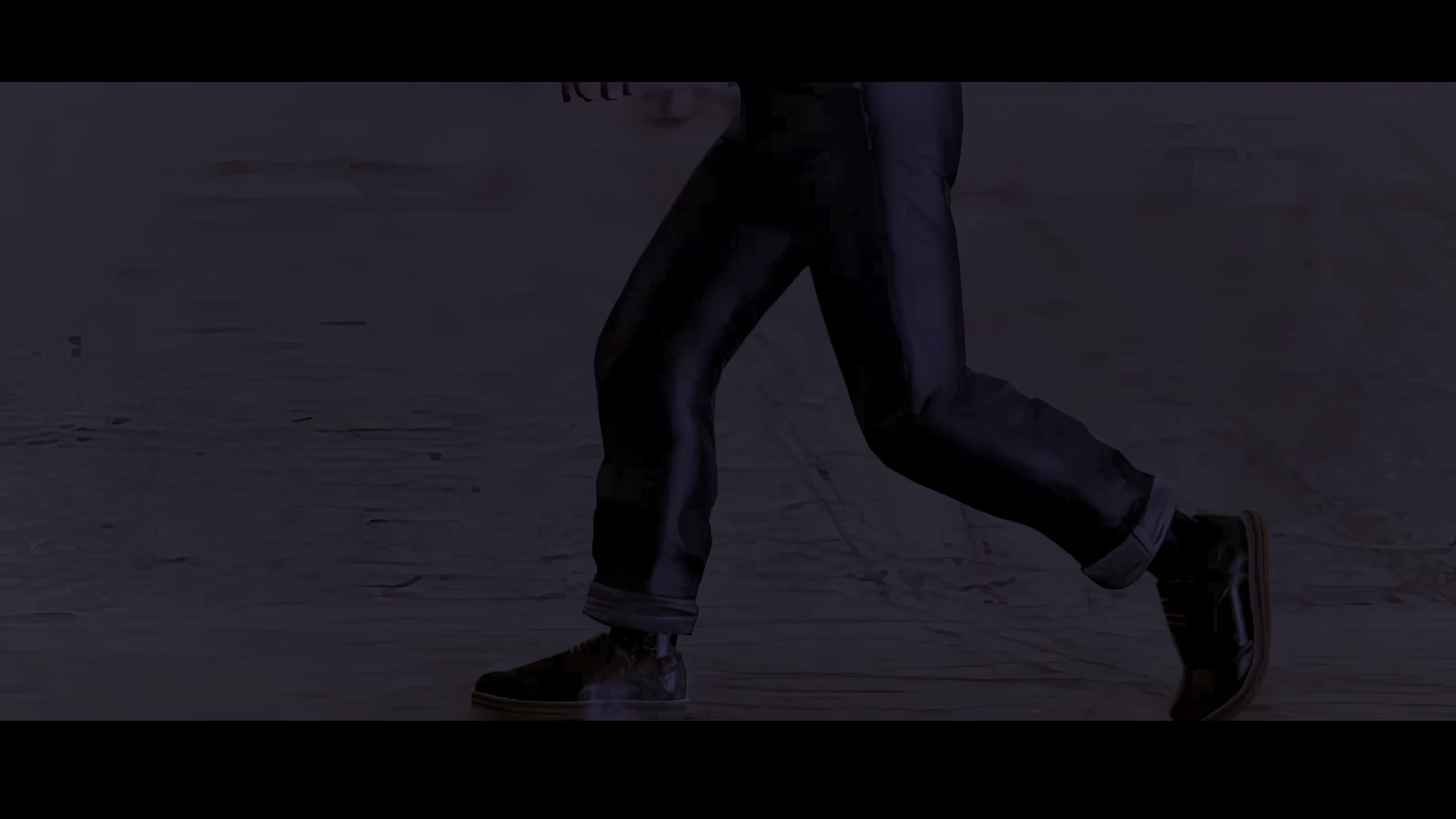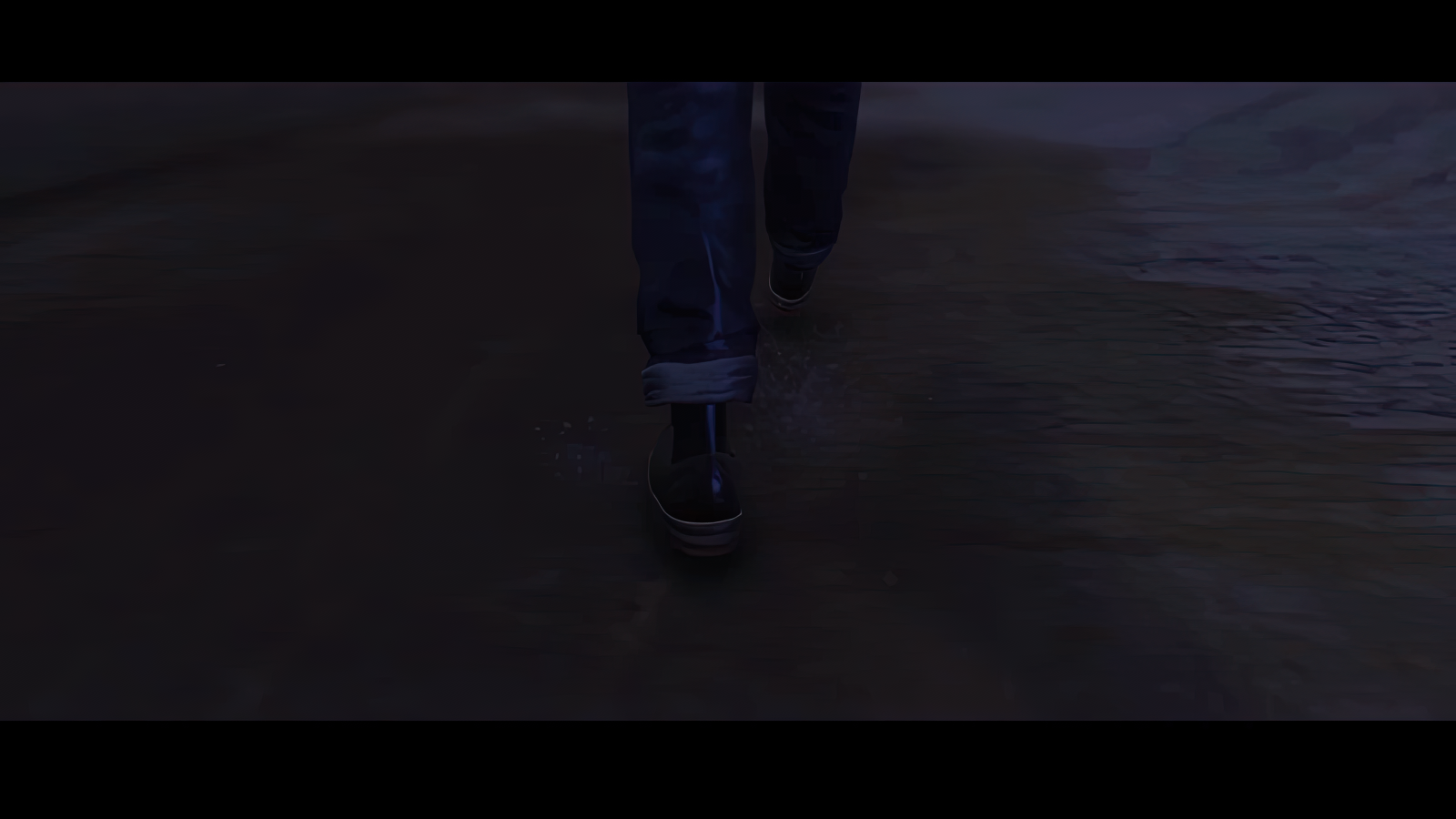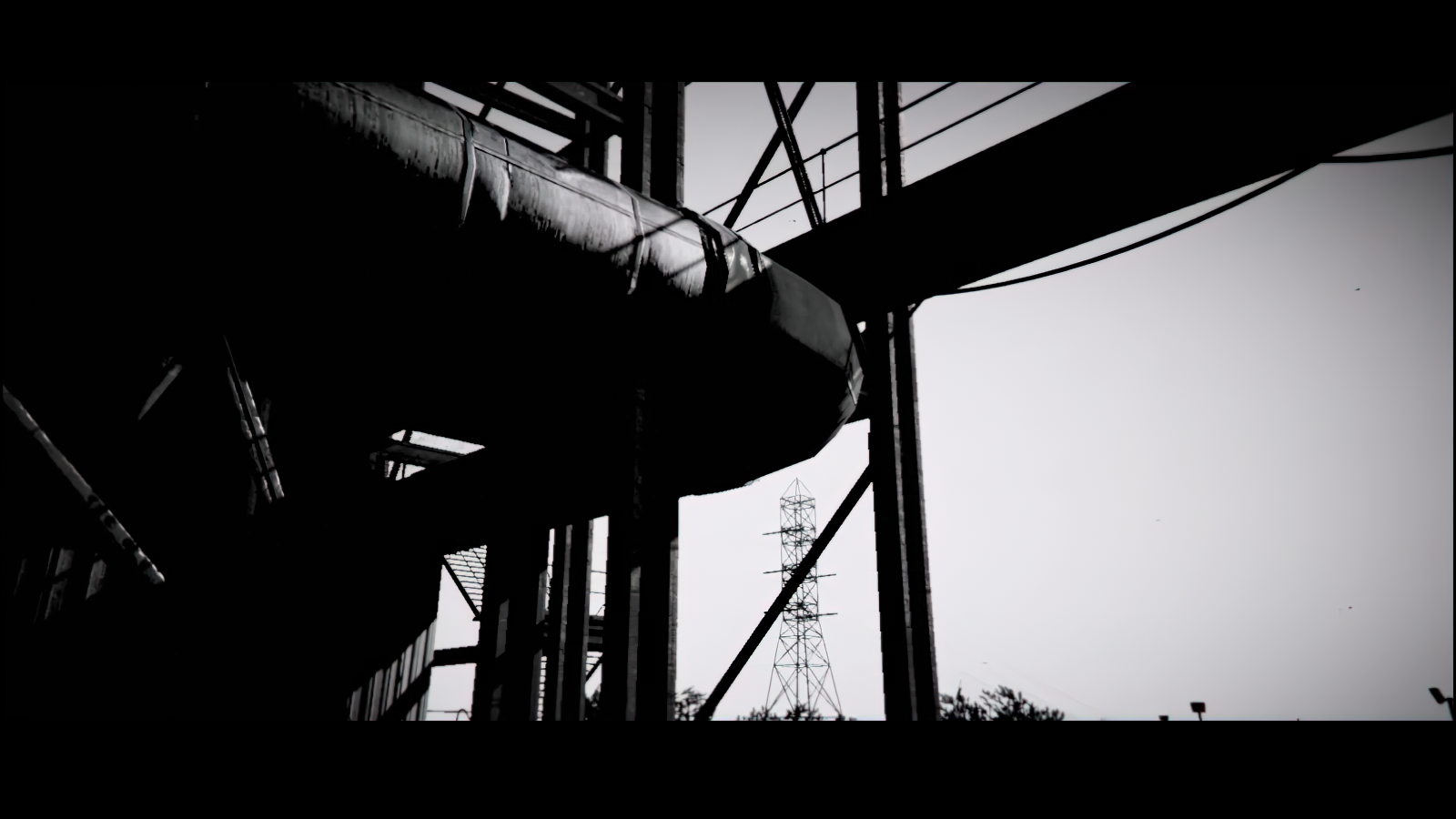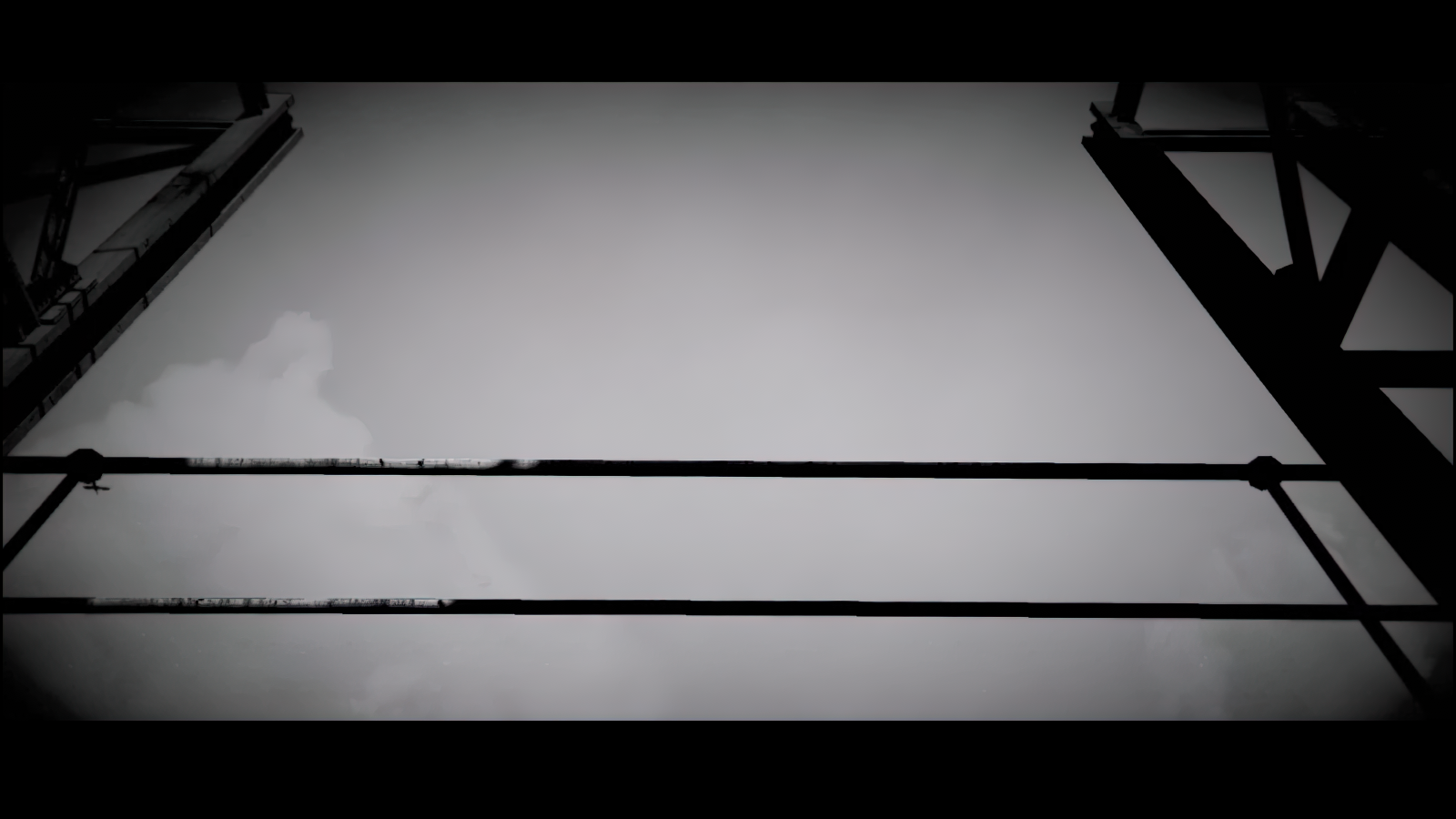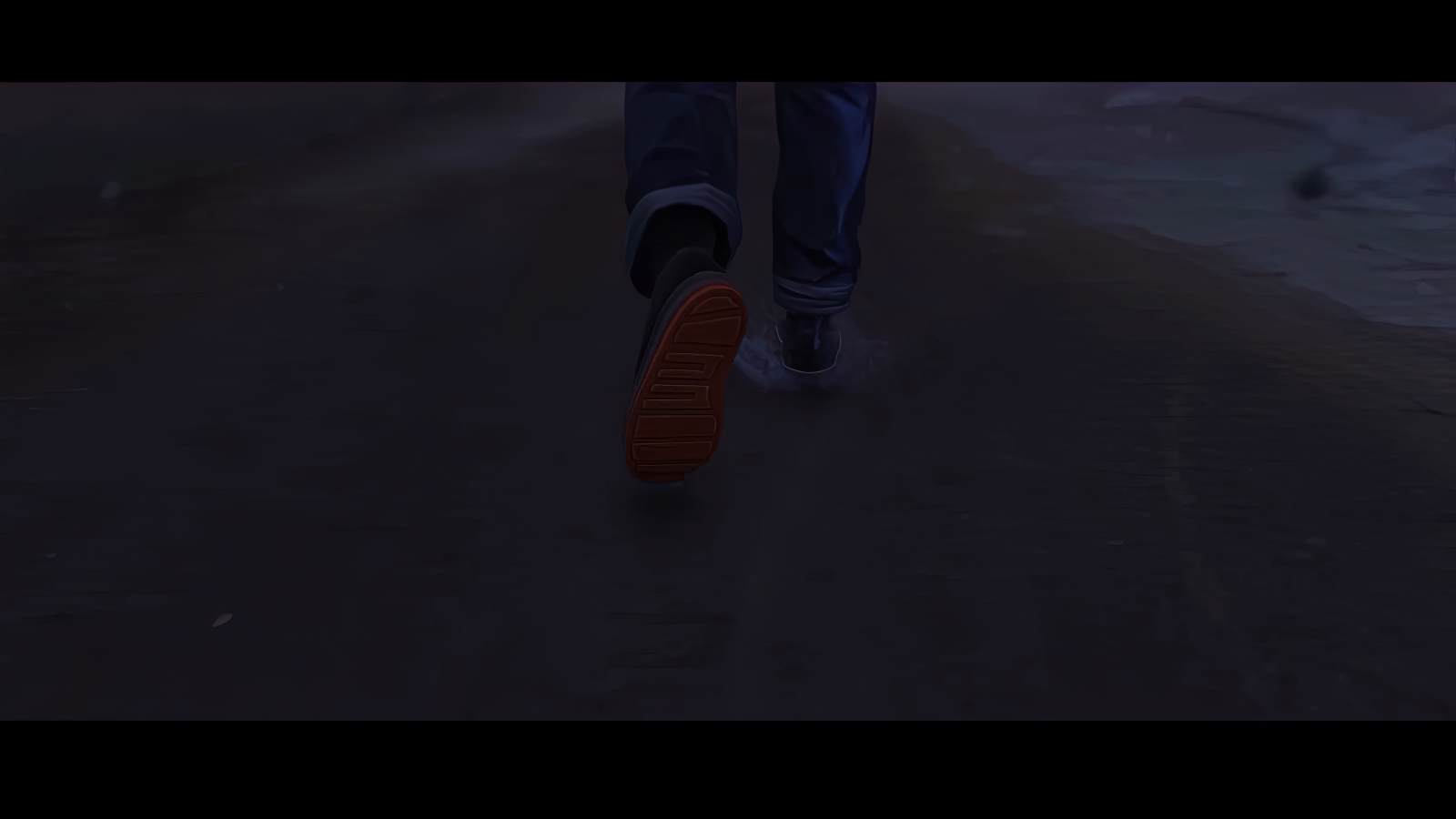FACING THE WOLF
machinima/digital video (1600 x 900), color, sound, 19’ 26” (chapter I: 5’ 15”, chapter II: 5’ 21”, chapter III: 8’ 50”), 2021, United Kingdom.
Created by Iain Douglas and Mark Coverdale
Facing the wolf is a machinima trilogy produced over the course of 2021 by appropriating and repurposing Grand Theft Auto V. The artists decontextualized the characters and locations of the original video game to tell a story of redemption and reconciliation, so that an uneasy truce with the past may be reached. In broad terms, these three videos reflect on war, loss, grief, and class struggle, themes which never seem to be as far away as they ought to be. As war has now become a reality for millions of people in Europe, Facing the wolf can be seen as a cautionary tale. Or, perhaps, a premonition.
Iain Douglas is an artist working with machinima, game engines, film, and materials like paint and plaster. Iain’s practice explores the themes of cultural and individual loss. For more information, please visit his website.
Mark Coverdale is a widely published performance poet, writing from the picket line, art gallery, and the terraces. Mark’s poems for these machinima are drawn from his interests in domestic industrial decline and the troubled events of the New European East. He lives and works in London. For more information visit his website.
Matteo Bittanti: Can you briefly introduce yourself and your practice? How and when did you begin using video games as an expressive form, that is, a creative tool as opposed to entertainment? How would you describe your process? And how did your collaboration begin?
Iain Douglas: My early career was as a AAA game developer where my role was to make environments and the assets within them. I had studied Fine Art for my Bachelor of Arts and was always in love with installations and all things digital, so my job was very similar, using assets to tell stories in created spaces. It was also great fun and an opportunity to keep learning. I mostly kept my ‘work’ and my Art separate however, and it was only after I ended my full time career that I started to bring the two parts together. I made my first machinema, i didn’t get to kiss you goodbye, as a response to a call by David Blandy for a collection he was curating called “Fields of Algorithms”. I’ve been completely absorbed by them ever since.
Mark Coverdale: We met at Art School, at Reading University in 1997. Skip forward 24 years, then during lockdown, Iain approached me about working on some machinema together. This collaborative approach was something new for both of us and was something we could do, stuck in our homes. Iain gave me an outline of an idea and showed me a rough draft of Facing the Wolf part i. We talked a lot about how we wanted it to look and sound, and I already had a poem which acted as the repeated refrain, as heard in the background. As someone not familiar with video games at all (except for Niall O’Sulivan’s foray into live streaming Red Dead Redemption 2, as he rode the landscape and wrote haiku, definitely an inspiration), I was gripped by how cinematic it looked, felt and sounded. We were in a film, in a character’s head, and I wanted to exploit that canvas whilst making a commentary on war and the decline of industry.
I should also mention how lucky I am to have my good friend and workshop colleague Oscar Crawford on board. He doubles as a professional sound recordist and was more than keen to lend his recording skills and post-production tips to our machinimatic cause, so we were very grateful for his aid and insight.
Matteo Bittanti: A question for Iain: You’ve worked on several video game projects, including popular racing games like GRiD and DiRT. Interestingly, the body of machinima work that you have created does not qualify as promotional or self referential, as the vast majority of vernacular machinima. On the contrary, it’s very personal, intimate, and unapologetically poetic. What is machinima to you? I also notice that you spell it “machinema”, like it was originally intended by Hugh Hancock and Paul Marino. Matters of nomenclature are not purely academic, so I’m very interested in knowing more about your relationship to the medium.
Iain Douglas: Hmmm tough questions :) Well to me, machinema is solitary. Even though I make these with Mark, it’s hours and hours alone at my computer walking, re-walking, editing, exporting, waiting and reflecting. The process is very solitary and the game spaces can become lonely too as they’re not online, I’m the only presence with any real agency. So our machinema, for me at least, are a reflection of that time and the process of being an artist and probably a bit about how I feel as a human.
You ask about the work not being self referential, well I still like it when games break, when they do something that pulls back the curtain and reveals the wizard, but I’m less motivated by those moments because I have been that wizard. I’m more interested in taking existing spaces people are familiar with and recontextualizing them – as artists sometimes do with installation – the objects in the space take on new meaning and tell new stories. I have used actual glitches in machinema, but not for their revelatory abilities, rather as parts of the story (Gallery Eyes) for characters to observe and reflect on. In that example we have a moment where our main character observes a glitch and for her that’s a metaphysical moment.
On the question of spelling, the answer is really mundane I’m afraid. I’m old and I’m just used to seeing and using both (sorry), I like the ambiguity.
Matteo Bittanti: I love this idea of machinima as a solitary activity, pretty much like writing, which requires focus, isolation, and an engagement with the machinic (the keyboard, the screen, perhaps the printer, as you get a hard copy that you review and revise, over and over). Likewise, machinima can also be a ‘monastic’ affair, with a hint of stoicism, as capturing the footage and then editing the outcome are cognitive intensive processes which require, you guessed, focus, isolation, and a close engagement with the machinic (in Ellen Ullman’s sense, although she was referring to coding). Perhaps that’s where machinima really comes from: sure, it is undoubtedly ‘machine animation’, but it is also (primarily?) about animating the machinic. Which brings us to Facing the wolf, which you developed with/in Grand Theft Auto V. Can you provide additional context about its origins? How did this project come to be? I’m especially interested in your ongoing collaboration with Mark Coverdale. Are the embedded poems available in a collection or online, by the way? Did you shoot the scenes in Los Santos based on an existing “script”, so to speak, or the work developed more organically, even improvisationally, as you wandered the streets of the virtual city?
Mark Coverdale: As both a poet and visual artist, I am always interested in ways of expanding my poetic practice. For example, myself and Aislinn Evans had a visual/poetic collaboration published in Magma 78. So when it came to working with Iain, I jumped at the chance as it is an area of artistic practice yet undiscovered. As a result of our long friendship, we collaborate very naturally, with an instinct of each other’s influences and artistic preferences, whilst able to suggest or criticise without fear of putting each other’s nose out of joint. Either Iain makes a film (most of the time) and I write to it, or the other way round, as in Gallery Eyes. All the poems are available here.
Iain Douglas: [Mark and I] meet up online and we talk over things, we send each other drafts and swap ideas. It’s fun because we like hanging out with each other and we have very different lives. When Mark sends me poems I read through them (or listen, if he’s sent an audio version) and I try to see them through the lens of a game or how I could create something that is a vehicle for them. The machinema are not really visualizations of the verse. So to answer your question, they grow organically.
Facing the wolf came into being after I had had an idea when playing around with the editing tools in Grand Theft Auto. I had initially envisioned a really long journey where we followed an itinerant character as they saw the world by train and had various encounters on the way, kinda like Mike Brodie meets Carlos Casteneda. That morphed into a much darker version as lockdown and covid deaths spiralled. Part ii draws inspiration from Twin Peaks by David Lynch and part iii draws inspiration from Paris, Texas by Wim Wenders.
Mark Coverdale: After seeing Iain’s film for part ii, I was very much reminded of Jerzy Skolimowski’s Walkower, so I used that as an inspiration for my verse.
Matteo Bittanti: Facing the wolf comprises three chapters of variable length presented as “lessons”, which make the overall project akin to a parable or even a tutorial sui generis. The unwelcoming landscapes and Mark’s politically observational poetry perfectly complement each other. The first two episodes are urban, gritty, and dark. In part i, a man wearing a baseball hat and a leather jacket is walking alone at night, alongside a canal, only to disappear in a tunnel. This is not a dérive, a pleasure stroll. The man is going somewhere. He knows where he is going. Part ii juxtaposes the natural and the industrial: we see a crow flying over a bleak, polluting factory. The third “lesson” takes us to the desert: the silent man in boots and denim from the first machinima is back and so is the crow. We see oil fields, a highway or freeway, an industrial plant. The juxtaposition is, again, striking and unnerving. Can you elaborate on this progression (or regression)?
Iain Douglas: Without getting too heavy or explicit, the three chapters tell a loose story or perhaps as you suggest a parable, about loss and possible redemption. I don’t want to pin them down too much or explain them away, but hopefully viewers will see there is a path. Our main character walks alone in the rain having made a decision to face up to his demons, he isn’t looking for anything new, this is a familiar space and he has a destination. As he strides onward, we hear him repeating verse over and over like a mantra. Are we privy to his thoughts? Or is he repeating these words aloud as he goes? Over the top there is a higher level, clearer voice – they’re both the same voice (Mark’s), with the second powerful voice, are we hearing a reflection or narration on events from some time in the future when the dust has settled?
You may notice in the parts there are points of self reference – in part i, we hear about the ‘red dirt off the pit top’ and “a pilon hosts a crow” – are these foreshadows of part iii where we actually see these for real? Again with Part ii – “Two houses on fire brackets genocide”, maybe they are memories from the characters' past life in that place?
The verse is about war and loss both personal and cultural. Mark and I were both working class kids and we lived in areas surrounded by deprivation as industries took a beating. As well as reflecting our views on politics, Mark is also very interested and passionate about the events that happened in Bosnia and really wants to tell that story too.
Mark Coverdale: As Iain put very well, I like to write poetry that is both direct and ambiguous at the same time. I pick language that takes you right to the physical, emotional and historical setting of the narrative, whilst purposefully leaving the intent unclear. It’s about being specific and universal at the same time. The idea of these linear/abstract stories being metaphorical in nature has a strong appeal to me.
Matteo Bittanti: I saw on Twitter that you are developing a comic book based on Facing the wolf. This qualifies as a “gamic” or a comic book created with a video game, a format which enjoyed some popularity approximately a decade ago. I find it very interesting. How is the project going?
Iain Douglas: Ha ha ha, yes! I’m glad you saw it :) We had thought about writing a whole comic/graphic novel that covered events in between the parts.
Part i is very clear cut – it’s very straight – there’s a guy on a journey – but part ii is way more conceptual with long camera pauses – faux glitches – time spiralling out of control. I wanted the pages to add something to the space between these two parts, so we get introduced to the Crow - the Crow who is always following our character - the Crow from the pilon in part iii who at the very end emulates a fighter jet. In the pages I shared we see the bird as an agent of change when, in the form of a shadow, it leaves a tarot-like card for our character.
Mark Coverdale: As a small-time independent publisher, the accompanying book or ‘zine would be a complimentary yet stand alone by-product of the trilogy. It would be an addition as opposed to an explainer, but would let us explore another multi-media approach to the project. Hopefully with some exposure and backing we can get it made.
Matteo Bittanti: I wanted to get back to your first machinima, i didn’t get to kiss you goodbye (2021), which as you mention, was featured in a curated selection by David Blandy for The One Minutes. You captured the tragedy of dementia with a poignant short which uses blurriness as a metaphor for cognitive impairment. We see an elderly woman in a parking lot under torrential rain. The camera zooms in on her although the image does not get any clearer. Soaked in her trench coat, she just stands there, motionless. In the accompanying text, you wrote: “Around her the world continues but it too is suffering from a cultural and historical dementia.” I found it very powerful and touching. Can you elaborate?
Iain Douglas: I’ll try, but a lot of the time when I make things it’s a way of helping me articulate ideas because I’m very visual. My Mum – the woman in the rain? – died of dementia and as she suffered and lost her memories she became just a shell, as the memories faded so did she. We as individuals are our memories. I think that culturally we are also our shared memories and histories. As we read less and instead rely more on tv/film/the internet to fill the gaps with catchy headlines, it seems to me that too many things are being lost. A lot of my artwork has involved folklore like the story of Zellandine, she had a horrible time and whilst she was unconscious she was raped by Troilus, well that story has almost gone now, instead we have the saccharine/white washed version Sleeping Beauty. I think it’s the same with factual history, especially in the UK with the history of the working classes.
Matteo Bittanti: Loneliness is a recurrent theme in your oeuvre. In Facing the wolf, i didn’t get to kiss you goodbye, and strangler’s attic we see lonely characters, standing, walking or falling into the void… alone. They are all in the world, but not with the world. Is the isolation that you depict in these machinima the primary attribute of the human condition as you and Mark see it?
Mark Coverdale: I think the characters in the machinima speak to my dichotomic belief that the world is both full of the worst kind of people, and that our collective empathy, solidarity and faith in the best of humanity will overcome any attempts to destroy it. On an increasingly individualistic planet, collective action is the only progression we can strive for. I feel the loneliness and despair of our characters is an echo of this sentiment. There are several strands of my poetic research that I draw upon that speak to this. Firstly, through my interest in the events in Bosnia in the 1990s, initially through the journalism of Ed Vulliamy, up to now having become a ‘building stronger communities champion’ with Remembering Srebrenica. Through this work there is one aspect that is often used as the most powerful tool in combatting hatred and genocide denial – the victims’ stories. Secondly, through my work with Poetry on the Picket Line and writing about post-war industrial Britain, there is an obvious theme of the struggle of the individual and the power of the collective, and vice versa. The relationship between the individual and their place in society is a constant thread in my writing, so not necessarily the primary attribute of the human condition, but an insightful question nonetheless.
Matteo Bittanti: Several, if not all your machinima, are overtly political. REVOLT is especially striking. Here Coverdale’s piercing prose expresses contempt to “the arrogance, ignorance and incompetence of the conservative government’s treatment of the arts”, as you wrote in the accompanying text. Was this machinima inspired by Project X, a 1987 movie starring Matthew Broderick, by any chance? It seems unlikely as we previously met the chimpanzee in oranges are not the only spill, but I had to ask… Plus the cinematic primate was named Virgil and yours is Albert. At any rate, you state that the animal represents “the loss of free will”. Are you suggesting that we are born free, but then find ourselves enslaved by the various political systems – the cage – that we create, something that Giorgio Agamben, riffin’ on Michel Foucault’s “dispotif”, calls the ‘apparatus’? If so, is artist production a possible (the only) way out of such imprisonment?
Iain Douglas: You have the order slightly wrong, we do in fact first see Albert in REVOLT where he escapes from a military facility determined to author his own life. Albert ii was the first primate in space but what happened to Albert i? Well, we’ve found him. He escaped from the facility and is now out and about exploring (and yes there is some Project X in there!! Also the movie poster I made to go with it is based on Falling Down).
Matteo Bittanti: Thank you for the clarification. Now, it makes perfect sense.
Iain Douglas: Regarding your question about the loss of free will, yes, that is significantly how it feels in the United Kingdom, except we have very little control over the cage as it has been in place for centuries and is very well refined and well tuned to squashing dissenting voices. Working Class kids can (are permitted?) escape but there are many gatekeepers on the way. There is a brilliant writer and commentator Darren McGarvey who talks so eloquently about the plight of the working class, even as he writes about it he can see how once he starts to get money and get noticed, he is moving class and becoming assimilated. If you create value for others then you’re allowed to leave, Footballers are allowed to leave, value generating Artists etc are allowed to leave.
Mark Coverdale: In essence it’s a pretty on-the-nose response to one of the cornerstones that right-wing ideology holds dear. That art has no value beyond commercial means. Also, repression of expression quashes any creative dissent. Admittedly this is an albeit too brief delve into this theory, but I do like your suggestion that we are born free until we are enslaved to the political system. There are other factors that we could discuss, but it is this very system, which produces the Reskill, Rethink, Reboot campaign from which we have to artistically fight ourselves free.
Picking up from Iain’s point about being allowed to leave only if you create value, this is a sentiment widely echoed by Victoria McNulty and other working-class poets and artists that I admire. The life-story of the poet John Clare (1793-1864) being an excellent illustration of how the cocktail of working-class roots, success and subsequent treatment as an artist, can paint someone as a fascinating amusement, a fatalistic lunatic, an outcast and a darling all at once. However, I think we can both agree that the phrase ‘art will set you free’, however trite that sounds, will always play its part, whether there’s a commercial attachment to this ideal, or not.
Matteo Bittanti: Facing the wolf has a very unique format: the aspect ratio is 1600 x 900. Aesthetically speaking, this creates an incredible mood, one that is both vintage and ultramodern, and it’s also quite rare for machinima. I was wondering if you could briefly explain this stylistic choice.
Iain Douglas: When I was making these videos — and giving them the borders — I was firstly imagining seeing them projected on a wall or screen in a dark room rather than solely on a monitor. So I wanted them to feel big knowing they would most likely actually just be seen in an intimate way on a screen, if that makes sense.
Los Santos is an ‘urban’ Wild West and I was thinking about the expanse of the screen in the Sergio Leone classics like Once upon a time in the West, with our character as a contemporary drifter. I wanted to capture some of that feeling. Is he the hero or the anti-hero etc. This is the reason I colourised the footage as well, to similar colours as the film stock.
Matteo Bittanti: I completely agree: Facing the wolf proves, once again, that machinima should be projected onto a large screen rather than watched on a computer monitor. Is there anything else you’d like to add?
Mark and Iain would both like to extend our deepest gratitude to Oscar Crawford who very kindly donated his time and skill to recording Mark’s audio.
FACING THE WOLF
machinima/digital video (1600 x 900), colour, sound, 19’ 26” (chapter I: 5’ 15”, chapter II: 5’ 21”, chapter III: 8’ 50”), 2021, United Kingdom.
Created by Iain Douglas and Mark Coverdale
Special thanks to Oscar Crawford
Made with Grand Theft Auto V (Rockstar Games, 2013)


